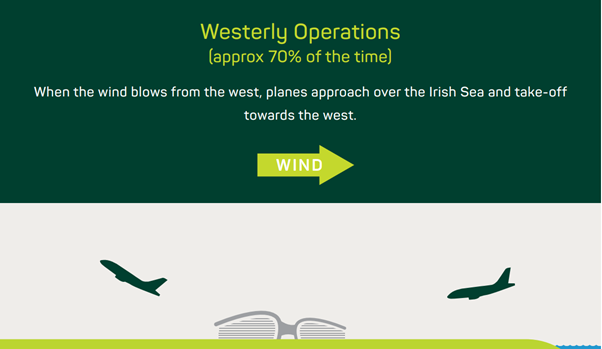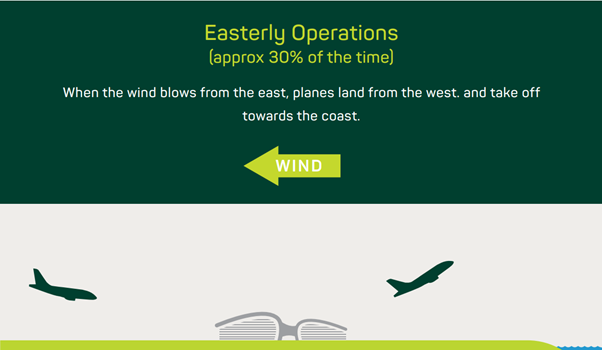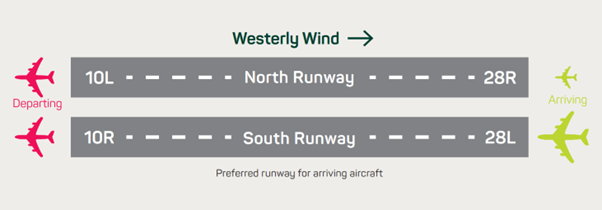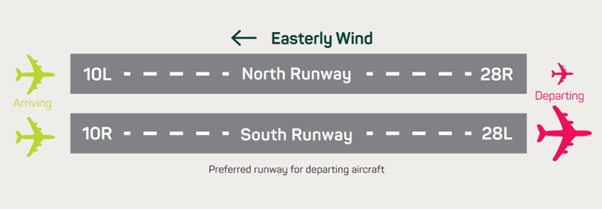Dublin Airport operates three runways: 10R/28L (South Runway), 10L/28R (North Runway), and 16/34 (Crosswind Runway). Their use is determined by planning conditions, regulations, operational constraints, weather conditions, and essential maintenance requirements. This careful management ensures efficient and safe management of all aircraft movements.
Wind Direction
The primary factor determining the direction of aircraft take-offs and landings is the wind. Aircraft take off and land into the wind to ensure maximum lift and control during these critical phases of flight.
In Ireland, the prevailing wind blows from the west. As a result, about 70% of the time, planes approach Dublin Airport over the Irish Sea and take off towards the west. This helps aircraft achieve better performance and safety.
When the wind shifts and blows from the east, the approach and departure directions reverse. In such cases, planes land from the west and take off towards the east.
Additionally, Dublin Airport has a Crosswind Runway (16/34), which is used only occasionally for essential safety reasons. This runway is reserved for situations when the main runways cannot be used due to specific wind conditions or other factors impacting safe operations.


Operational Criteria
The criteria for determining which runway is used for aircraft departures and arrivals at Dublin Airport are outlined in the 2007 North Runway planning permission conditions. This operational mode, referred to as Option 7B, aims to reduce aircraft noise impact on local communities. The decision on which runway to use at any given time is determined by Air Traffic Control and is based on criteria such as weather, safety, and planning conditions.
Mode of Operation 7B includes:
- Runway Preference: The parallel runways, 10R/28L (South Runway) and 10L/28R (North Runway), are preferred over 16/34 (Crosswind Runway)
- Westerly Operations: When winds are westerly (about 70% of the time), Runway 28L is preferred for arriving aircraft. Either Runway 28L or 28R can be used for departing aircraft, as determined by air traffic control.
- Easterly Operations: When winds are easterly (about 30% of the time), either Runway 10L or 10R can be used for arriving aircraft, as determined by air traffic control. Runway 10R is preferred for departing aircraft.
Westerly Operations (approx. 70% of the time)

Easterly Operations (approx. 30% of the time)

Runway Operational Hours
- South Runway: Operational 24 hours
- North Runway: Operational from 7:00 AM to 11:00 PM. Hours may be extended for essential maintenance or safety reasons.
Instrument Landing Systems (ILS) Checks at Dublin Airport
Dublin Airport conducts mandatory flight checks for its Instrument Landing Systems (ILS) biannually.
These checks are essential to ensure compliance with European Aviation Safety Authority (EASA) regulations, as mandated by the Irish Aviation Authority (IAA).
During these checks, a small twin-engine aircraft performs multiple approaches to each end of the North Runway (10L/28R), the Crosswind Runway (16/34), and the South Runway (10R/28L), flying no lower than 100 feet. The aircraft then makes several passes of each runway at approximately 50 feet. These tests, usually conducted over three consecutive nights between 11 PM and 6 AM, help maintain the accuracy and reliability of the ILS, which is crucial for safe landings in poor visibility.
Additionally, the South Runway (10R/28L) might be temporarily closed for daylight inspections, with the North Runway (10L/28R) handling all operations during such times. These procedures are vital for ensuring the safety and efficiency of flight operations at Dublin Airport.
